Request materials
UPDATES
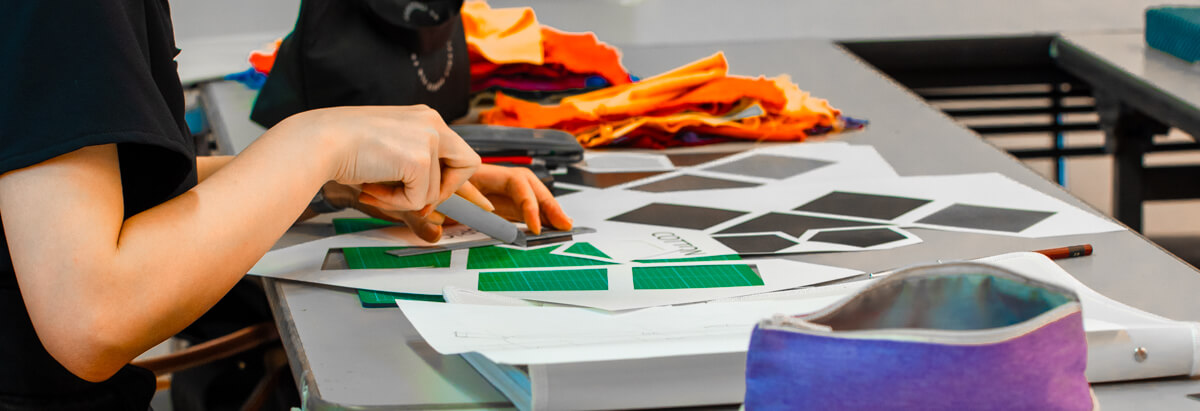
Talk Show with Esteemed Speakers: “Behind the Scenes of a Fashion Show” | SUMMER FESTIVAL DAY 2
At ESMOD Tokyo, we held the open campus event “Summer Festival” from Saturday, July 27th to Wednesday, July 31st! During the event, we offered workshops and talk shows to showcase the classes and techniques available at ESMOD Tokyo, as well as provide a creative and enjoyable fashion experience unique to the summer season.
In this blog post, we report on Day 2 of the Summer Festival, held on Sunday, July 28th, featuring the talk show “Behind the Scenes of a Fashion Show.” We revisit the insightful 90-minute session that delved into the objectives behind fashion shows, key points to consider when viewing them, and more.
Three Leading Figures in the Fashion Industry Took the Stage!
For this talk show, we invited three distinguished guests from the forefront of the fashion industry:
- Hiroshi Komoda, Secretary-General of the Japan Fashion Week Organization (JFWO), which organizes Tokyo Collections.
- Harunobu Murata, Designer of the collection brand “HARUNOBUMURATA” and an alumni of ESMOD Tokyo.
- Kaname Murakami, Editor-in-Chief of WWD JAPAN, who served as the moderator.
Each speaker shared their unique perspectives on the “realities of fashion show production” from their respective roles in operation, creation, and communication.

Why HARUNOBUMURATA Holds Fashion Shows
Harunobu Murata
HARUNOBUMURATA has participated in Tokyo Collection four times to date. The initial inspiration to hold a fashion show came during my time at ESMOD, where I was deeply impressed by the high level of the graduation collections. As I watched various fashion shows, my desire to host my own fashion show grew stronger when I launched my brand. I believed that showcasing models wearing the clothes and providing comprehensive production, including sound and spatial design, would convey the brand’s world and message in ways that photographs alone could not. Around that time, we won the “TOKYO FASHION AWARD 2022” hosted by JFWO, which allowed us to participate in Tokyo Collection for the first time.
Kaname Murakami
After participating in Tokyo Collection, did you feel the significance of presenting in a fashion show format?
Harunobu Murata
The greatest significance was the increase in the brand’s visibility. It felt like we gained a means to convey our brand’s message. Although it required more effort, mental energy, and cost than expected, I believe the fashion show brought even greater value.
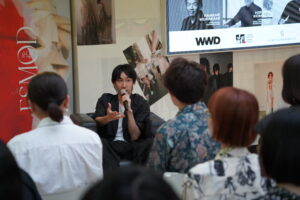
How Tokyo Fashion Week Supports Brands in Hosting Fashion Shows
Hiroshi Komoda
From the perspective of planning and operation, I strongly encourage brands to convey their world through fashion shows. While exhibitions and lookbooks can showcase the “quality of the garment itself” such as fabric and design details, fashion shows uniquely highlight how a garment can be styled to look its best, including hairstyles and accessories. Fashion Week serves as a “platform for challenge” where designers express their vision.
Kaname Murakami
Do many designers have the motivation to challenge themselves in the “expression stage” of a fashion show?
Hiroshi Komoda
Yes, I believe so. However, the challenges include the enormous costs involved in lighting, sound, and production, which can be difficult for brands. Brands need to generate profits from the show, invest in future fashion shows and exhibitions, and continuously communicate their vision in a positive cycle. At JFWO, we support brands to maintain this cycle for decades to come. We also work to create a supportive environment for the next generation of designers through awards, prize money, providing official venues, introducing production and PR staff, and inviting media for coverage.
What Brands Should Do to Express Their Vision in a Show
Kaname Murakami
Harunobu Murata, what specific steps did you take for your first show?
Harunobu Murata
Organizing a fashion show involves many elements such as production, lighting, and on-the-day photography, and I didn’t even know where to start. So, I began by finding a “show producer” to manage these processes. I contacted a production team I found online and requested their services. We discussed the show concept and the vision I wanted to convey, and based on this, the team provided venue and production suggestions. I feel fortunate to have met a great production team for my first show.
Kaname Murakami
Regarding the upcoming 2024 Fall/Winter collection, how did you express your brand’s vision?
Harunobu Murata
For this season, we deliberately chose to hold the show in a “non-fabricated space.” Previously, we had used elegant venues like top-class hotels or national museums to reflect an elegant theme or atmosphere. However, for this collection, I thought it would be interesting to create a luxurious show in a space that was the complete opposite of luxury. We used the floor as is and simply propped up plain walls to create a “non-overdone” space.
Kaname Murakami
What was the significance of the digital signage used in the production?
Harunobu Murata
The theme for this show was “Three Farmers Heading to a Ball.” This was inspired by a photo from the 1910s of three farmers heading to a dance party in a neighboring town. The photo also metaphorically represents the era of war that followed, which led us to adopt “Prosperity and Decay” as the show concept. We used generative AI to create imagery of “flowers,” a metaphor for “Prosperity and Decay,” and displayed it on the signage.
Kaname Murakami
I see. Because the theme was “Three Farmers Heading to a Ball,” the collection featured both rustic, everyday clothing and garments that conveyed the dress-up aspect for the ball.
Harunobu Murata
Exactly. By expressing “the joy of dressing up,” I hoped to capture the essence of “the joy of adornment” itself.
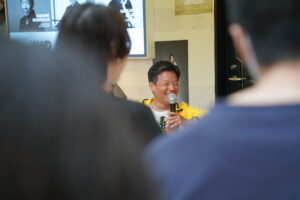
Kaname Murakami
As someone who sees many brand collections due to my work, I believe that “fashion shows are filled with messages from designers.” I hope everyone can learn to consider and interpret “what messages the designer wants to convey” from various perspectives. As mentioned by Mr. Murata, every aspect of the show—such as the choice of venue, sound design, and the models used—carries meaning and attention to detail. Watching a fashion show with this mindset can make the experience even more enjoyable.
Hiroshi Komoda
From an operational standpoint, I’ve observed many brands, and designers who pay particular attention to the production and staging of their shows tend to have longer-lasting careers. It is also our role in operations to provide an environment that is suitable for expressing the evolving ideas of designers each season. We look forward to seeing designers and brands grow through their repeated show presentations.
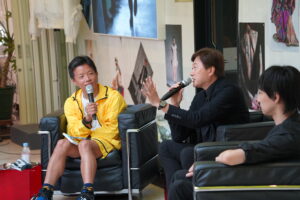
Kaname Murakami
Mr. Murata, having participated in the Milan Collections, did you notice any differences between Tokyo and Milan?
Harunobu Murata
The primary difference lies in the market where the brand is showcased. In Tokyo, it is challenging to attract global media and buyers due to the geographical and logistical issues. In contrast, Paris and Milan are closer in timing, making it easier for media and buyers to gather. This proximity creates more opportunities for brands to be evaluated during the fashion weeks and exhibitions.
Kaname Murakami
I see. Mr. Komoda, from an operational perspective, what is your vision for the future of Tokyo Collections?
Hiroshi Komoda
Japan, being an island nation in Asia, faces challenges in gathering people and information compared to European collections. However, I believe Tokyo does not need to compete with other fashion weeks. Tokyo has a unique fashion scene that stems from Japanese culture. Many globally recognized brands, such as Yohji Yamamoto, COMME des GARÇONS, and Issey Miyake, use textiles crafted with traditional Japanese craftsmanship. This focus on textile creation and conceptual design is highly valued.
Our role is to discover and promote the next generation of designers who will continue this tradition.
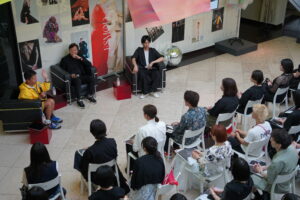
Q&A Session – We answered questions from participants!
Q: How many people are involved in a fashion show?
Harunobu Murata
A fashion show involves over 100 people, including venue production, hair and makeup, models, fitters, design teams, garment alteration staff, sound and visual teams, and PR staff. With so many people involved, the pressure is quite high for each show.
Q: How much does it cost to hold a show?
Harunobu Murata
It typically costs around 10 million yen. We strategize based on funding sources and projected returns post-show to determine the investment amount. Ideally, as a brand’s visibility and expectations grow, it becomes possible to hold larger-scale shows, but achieving this requires business success.
Q: While it’s common to invite media and VIPs to fashion shows, is selling tickets like for theater or concerts ever considered?
Harunobu Murata
Brands aim to increase their visibility through fashion shows, which is why they prefer to invite media and influential figures rather than selling tickets to the general public. The invite-only format is believed to better align with the brand’s goals and message.
And finally, a cocktail party was held!
After the talk show, a cocktail party took place. All three leading figures joined the event, providing a valuable opportunity for participants to interact. Their thoughtful responses to questions left a strong impression, and participants were visibly excited!

#EsmodTokyo #SummerFestival #OpenCampus #Talkshow #FashionShow #BTS #TokyoCollections #RakutenFashionWeek #harunobumurata #WWDJAPAN #FashionInternationalSchool #FashionSchool
Join Us for the Next Open Campus on September 14:
“Create a Zero Waste Dress — ZERO WASTE PATTERN”
Beginners are welcome to participate!
When making clothing, fabric scraps and waste are inevitable. This time, we will focus on creating patterns with minimal fabric waste, based on the concept of “zero waste pattern.” You’ll design a dress that is both environmentally friendly and resource-efficient.
We look forward to seeing you there!
Writer’s Profile
Kyoka
A fourth-year university student currently interning at ESMOD TOKYO.

